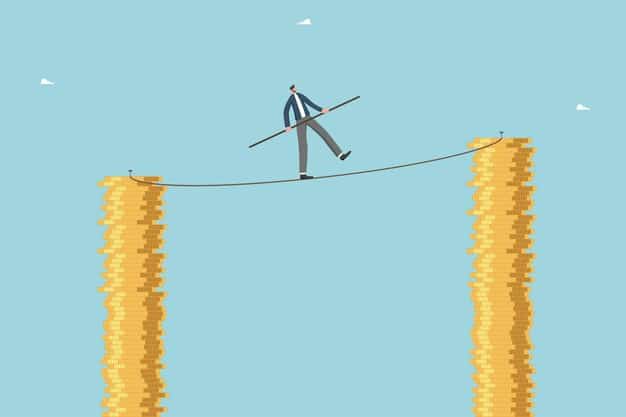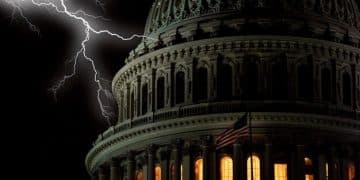US Debt Ceiling Debate: Risks & Economic Ramifications Explored

The recurring debate over the National Debt Ceiling Debate Resurfaces: Potential Risks and Economic Ramifications involves Congress setting limits on the U.S. government’s borrowing, with failure to raise or suspend it potentially triggering a default on national obligations, leading to severe economic and global financial instability.
The perennial discussion surrounding the National Debt Ceiling Debate Resurfaces: Potential Risks and Economic Ramifications demands serious attention. This isn’t merely a political skirmish; it’s a critical financial standoff that carries tangible risks for the U.S. economy and, by extension, the global financial landscape. Understanding its nuances is crucial for any engaged citizen or investor.
understanding the debt ceiling and its origins
The U.S. debt ceiling, often a lightning rod for political contention, is a statutory limit on the total amount of money the federal government can borrow to meet its existing legal obligations. These obligations include Social Security and Medicare benefits, military salaries, interest on the national debt, tax refunds, and other payments.
The concept itself dates back to the Second Liberty Bond Act of 1917, which allowed the Treasury to issue bonds without specific congressional approval for each issuance, providing greater flexibility during wartime. However, it also set an aggregate limit on total federal debt.
historical context and purpose
Initially, the debt ceiling was intended to provide more flexibility than requiring Congress to approve each individual bond issue. It streamlined the borrowing process and gave the Treasury department some autonomy, while still keeping a legislative check on overall federal indebtedness. Over time, it transitioned from a procedural convenience into a potent political tool.
Understanding its historical evolution helps to contextualize current debates. What began as an administrative measure now regularly becomes a high-stakes negotiation, with profound implications for fiscal policy and economic stability. The mechanisms put in place over a century ago now underscore the intricate balance between legislative oversight and executive operational needs.
- Origin in WWI: Facilitated war financing by setting a total borrowing limit.
- Shift in Function: Evolved from administrative tool to political leverage point.
- Legislative Oversight: Congress retains power to raise or suspend the limit.
- Routine Adjustments: Historically, the ceiling was raised routinely to accommodate spending.
The debt ceiling is not a license for new spending. Instead, it covers expenses already approved by Congress. When the government approaches this limit, Congress must either raise, suspend, or permanently eliminate it to avoid defaulting on its existing financial commitments. Failure to act creates an economic and political crisis, as the government faces an inability to pay its bills.
the current debt ceiling debate: key players and positions
Each time the U.S. approaches its debt limit, a predictable pattern emerges: political factions leverage the deadline to push for their respective agendas. This typically involves calls for spending cuts, tax reforms, or other fiscal policy changes. The current iteration of the debate follows a similar script, marked by sharp partisan divides.
Key players often include the President and the Treasury Secretary on one side, advocating for a clean raise or suspension of the limit to prevent economic disruption. On the other side, congressional leaders, particularly those in the opposition party, link a debt ceiling increase to demands for significant fiscal concessions. These demands often involve long-term budget reforms or immediate cuts to government programs.

political posturing and economic implications
The political posturing inherent in these debates often escalates to the brink, creating uncertainty in financial markets. This brinkmanship, while intended to gain policy leverage, poses real risks. Businesses and investors prefer stability, and uncertainty surrounding the government’s ability to pay its bills can lead to market volatility. The longer the deadlock persists, the greater the potential for widespread economic unease.
The demands typically associated with these negotiations vary. Some factions may push for broad spending reductions across the board, affecting everything from defense to social programs. Others might target specific agencies or initiatives. The core issue remains: one side views the debt ceiling as a control mechanism for spending, while the other sees it as an obligation to pay for past commitments.
- Democrats’ Stance: Generally advocate for a “clean” increase to avoid default.
- Republicans’ Stance: Often demand spending cuts or fiscal reforms tied to an increase.
- White House Position: Aims to protect the nation’s creditworthiness and avoid economic fallout.
- Congressional Dynamics: Ideological divides shape negotiation strategies.
These negotiations are not just about numbers; they are about differing philosophies on government’s role and fiscal responsibility. The outcome invariably shapes budget priorities, impacts various sectors of the economy, and influences the nation’s financial credibility both domestically and internationally. The stakes are undeniably high, demanding a careful balance between political objectives and economic realities.
domestic risks of a debt ceiling default
The prospect of a U.S. government default, while considered unlikely by many, carries catastrophic domestic risks. A default would mean the U.S. Treasury being unable to pay all its legal obligations, ranging from bond interest payments to Social Security benefits. This scenario would trigger an unprecedented financial crisis within the country.
The immediate consequence would be a severe blow to confidence in U.S. government bonds, long considered the safest assets globally. Bond yields would likely skyrocket as investors demand a higher premium for holding what is now perceived as a riskier asset. This increase in borrowing costs would ripple through the entire economy, affecting mortgage rates, car loans, and business investments.
economic recession and job losses
A default would almost certainly plunge the U.S. into a deep recession. Consumer and business confidence would plummet, leading to reduced spending and investment. Companies would lay off workers, unemployment would surge, and economic activity would grind to a halt. Essential government services could face disruption as the Treasury struggles to prioritize payments.
The inability to pay federal workers, contractors, and beneficiaries like retirees would create immediate hardship for millions of American families. The ripple effect extends to state and local governments, which rely on federal funding and could face their own fiscal crises. The intricate web of the U.S. economy means that a single point of failure—the government’s inability to pay its bills—could unravel much of the progress made over decades.
- Sovereign Credit Downgrade: Rating agencies would likely downgrade U.S. debt.
- Interest Rate Spike: Borrowing costs for government, businesses, and consumers would rise.
- Stock Market Crash: Investor panic would trigger widespread selling.
- Economic Contraction: GDP would shrink significantly, leading to recession.
- Mass Job Losses: Businesses would cut staff amid economic uncertainty.
- Disruption of Services: Payments for Social Security, Medicare, and other programs could be delayed.
The long-term effects would be equally grim. The credibility of the U.S. as a reliable borrower would be severely damaged, hiking future borrowing costs for years to come. This “default premium” would act as a persistent drag on economic growth, making it harder for the government to invest in infrastructure, education, or other critical areas. The domestic landscape would be scarred by a crisis of confidence and persistent economic stagnation.
global ramifications of a u.s. default
The interconnectedness of the global financial system means that a U.S. debt default would send shockwaves far beyond American borders. U.S. Treasury bonds are the cornerstone of the international financial system, serving as the benchmark for safe assets and influencing global interest rates. A default would fundamentally destabilize this foundation.
Other countries, central banks, and international institutions hold trillions of dollars in U.S. Treasury securities as reserves. A default would drastically reduce the value of these holdings, impacting the stability of financial systems worldwide. Foreign investors would lose confidence in the reliability of U.S. assets, leading to a flight of capital and a potential global financial crisis.
international trade and currency impacts
The U.S. dollar is the world’s primary reserve currency and the currency of choice for international trade. A default would erode confidence in the dollar’s stability, potentially leading to its devaluation. This would disrupt global trade, making international transactions more volatile and unpredictable. Commodity markets, denominated largely in U.S. dollars, would experience extreme fluctuations.
Emerging markets, heavily reliant on dollar-denominated debt and trade, would face a particularly harsh blow. Their access to international capital would shrink, and the cost of servicing their existing dollar debt would skyrocket. The resulting economic instability could trigger a wave of defaults and financial crises in vulnerable economies, leading to social unrest and political instability across various regions.
- Loss of Global Confidence: U.S. creditworthiness severely damaged on the world stage.
- International Financial Instability: Global markets would experience unprecedented volatility.
- Impact on Reserve Currencies: Other nations might seek alternatives to the U.S. dollar.
- Disruption of Global Trade: Increased costs and uncertainty for international transactions.
- Emerging Market Crises: Countries with dollar-denominated debt would face severe challenges.
- Geopolitical Implications: Reduced U.S. influence and leadership due to economic weakness.
Beyond economics, a U.S. default could have significant geopolitical consequences. America’s ability to project power and influence worldwide is underpinned by its economic strength and the stability of its financial system. A default would weaken this foundation, potentially empowering rival nations and undermining alliances. The global ramifications would extend far beyond financial markets, touching upon diplomatic relations, security arrangements, and the very structure of the international order.
previous debt ceiling impasses and resolutions
While the threat of a U.S. debt default is consistently dire, the country has never actually defaulted on its obligations. However, there have been numerous instances where the nation came dangerously close to the brink, most notably in 2011 and 2013. These impasses provide valuable insights into the dynamics and potential outcomes of such high-stakes negotiations.
In 2011, a protracted debate between the Obama administration and House Republicans led to Standard & Poor’s historic downgrade of the U.S. credit rating from AAA to AA+. Although a deal was eventually reached, the uncertainty triggered significant stock market volatility and undermined global confidence in the U.S. economy. The episode illustrated the tangible costs of political brinkmanship, even without a full default.
lessons from past confrontations
The 2013 standoff, during another period of divided government, also saw the U.S. Treasury take extraordinary measures to avoid exceeding the debt limit. While a deal was reached relatively quickly in the final hours, the repeated pattern of eleventh-hour resolutions points to a fundamental flaw in the use of the debt ceiling as a regular bargaining chip. Each instance injects unnecessary volatility into markets and forces the Treasury to engage in complex financial maneuvering to avoid disruption.
These past crises highlight the importance of timely resolution and the potential for severe economic repercussions, even from near-misses. They also underscore the political motivations behind these impasses, often driven by ideological disagreements over fiscal policy and the size and scope of government. Learning from these historical events can inform future strategies and perhaps encourage more proactive engagement from policymakers.
- 2011 Crisis: Led to S&P’s downgrade of U.S. credit rating, significant market volatility.
- 2013 Shutdown/Debt Ceiling: Resulted in a government shutdown and a near-default scenario.
- Extraordinary Measures: Treasury employs accounting tactics to manage cash in crisis.
- Market Reaction: Uncertainty leads to bond yield increases and stock market dips.
- Political Costs: Damaged reputation and strained inter-party relations.
The recurring nature of the debt ceiling debate suggests that its use as a leverage point will likely continue as long as the mechanism remains in place. However, the increasing stakes, especially in a more interconnected and fragile global economy, demand that political leaders recognize the systemic risks involved. Past resolutions, while successful in averting disaster, came at a cost, serving as powerful reminders of the dangers inherent in these high-wire acts.
potential solutions and alternatives to the debt ceiling
Given the recurring nature and inherent risks of the debt ceiling debate, various alternative approaches and long-term solutions have been proposed. These range from procedural changes to more fundamental shifts in how the government manages its finances. The goal is often to remove the potential for economic catastrophe from partisan political squabbles.
One frequently discussed option is to eliminate the debt ceiling entirely. Critics argue that it is an archaic mechanism that serves no useful purpose other than to create unnecessary crises. Since Congress already approves spending through the appropriations process, some contend that a separate limit on borrowing to pay for that spending is redundant and dangerous. This approach would align the U.S. with most other developed nations that do not have such a statutory borrowing limit.
reforms and legislative proposals
Another proposal involves empowering the Treasury Secretary to raise the debt limit unilaterally, unless Congress passes a resolution of disapproval. This “Gephardt Rule”-like mechanism, which existed intermittently in the past, would shift the burden from requiring an affirmative vote to raise the limit to requiring a vote to block an increase. This could reduce the likelihood of impasses by making inaction lead to a raise rather than a default.
Other suggestions include linking the debt ceiling to the budget process, automatically adjusting it when a new federal budget is passed. This would integrate borrowing capacity directly with spending decisions, reducing the chance for separate, high-stakes confrontations. These reforms aim to depoliticize the issue and ensure the government can always meet its financial obligations without resorting to brinkmanship.
- Abolish the Ceiling: Eliminate the statutory limit entirely, as most developed nations do.
- Gephardt Rule Reinstatement: Automatically raise the limit unless Congress disapproves.
- Link to Budget Process: Tie debt limit increases directly to annual budget resolutions.
- Constitutional Challenge: Some argue the 14th Amendment renders the debt ceiling unconstitutional.
- Long-Term Fiscal Planning: Focus on sustainable spending and revenue strategies.
Ultimately, any solution requires bipartisan agreement and a willingness to prioritize national economic stability over political leverage. While the debt ceiling was originally conceived as a means of control, its current application often undermines that very goal by creating instability. A move towards more rational and less contentious mechanisms for managing federal borrowing would likely benefit the U.S. economy and its standing in the global financial system.
navigating future debt ceiling challenges
The recurring nature of the debt ceiling debate ensures that it will likely resurface in the future, demanding continuous vigilance from policymakers, economists, and the public. Navigating these future challenges will require a blend of political foresight, economic prudence, and a commitment to protecting the nation’s financial integrity. The lessons from past impasses should serve as a guide, underscoring the high stakes involved.
One key aspect of future navigation lies in proactive communication and transparency. The Treasury Department, Congress, and the White House must engage in early and open discussions about approaching deadlines and potential fiscal cliffs. Waiting until the last minute only amplifies market anxiety and reduces the time available for a reasoned solution. This strategic communication can help mitigate some of the harmful uncertainty that characterizes these debates.

the path forward: collaboration and preparedness
Another crucial element is the willingness to compromise. While partisan differences are inherent in democratic governance, the debt ceiling is arguably one area where principled stands must yield to pragmatic solutions for the greater economic good. Finding common ground, even if it involves difficult concessions, is preferable to a catastrophic default that harms all sectors of society. This necessitates a shift from brinkmanship to constructive negotiation.
Furthermore, building resilient economic safeguards is essential. This includes diversifying the nation’s economic strengths, fostering innovation, and maintaining strong international financial relationships. While some factors are within direct control, others, like global economic shifts, necessitate a robust and adaptable domestic policy framework. Preparedness for these future challenges involves a holistic approach—one that combines sound fiscal policy with political maturity and a long-term vision for economic stability.
- Proactive Engagement: Start discussions well in advance of a potential breach.
- Bipartisan Cooperation: Seek common ground to avoid economic disruption.
- Public Education: Inform citizens about the true risks of default vs. political rhetoric.
- Market Monitoring: Closely observe financial indicators for signs of distress.
- International Dialogue: Reassure global partners about U.S. commitment to its obligations.
The path forward requires a recognition that the debt ceiling is not merely a budget tool but a critical mechanism for national creditworthiness. Its challenges extend beyond domestic politics into the realm of global finance and stability. Successfully navigating these future confrontations will depend on an elevated sense of shared responsibility among leaders to safeguard the economic well-being of the nation and its global partners.
| Key Point | Brief Description |
|---|---|
| 📊 Debt Ceiling Basics | Statutory limit on U.S. national debt; Congress must raise/suspend it to avoid default on existing obligations. |
| 📉 Domestic Risks | Potential for recession, job losses, interest rate spikes, and a credit rating downgrade if default occurs. |
| 🌍 Global Impact | Threatens global financial stability, dollar’s reserve status, and international trade, impacting emerging markets. |
| ✅ Solutions | Proposals include abolishing the ceiling, linking it to the budget, or giving Treasury more authority to avoid crises. |
frequently asked questions about the debt ceiling
The U.S. debt ceiling is a legal limit on the total amount of money the federal government can borrow to meet its existing legal obligations, such as Social Security and Medicare benefits, military salaries, and interest on the national debt. It is not about authorizing new spending but paying for spending already approved by Congress.
The debt ceiling debate resurfaces because the U.S. government consistently spends more than it collects in revenue, necessitating borrowing. When the national debt approaches the statutory limit, Congress must act to raise or suspend it. This often becomes a political leverage point for parties to demand fiscal concessions or policy changes.
If the debt ceiling is not raised, the U.S. government could default on its financial obligations. This might lead to a sovereign credit downgrade, soaring interest rates for borrowing, a stock market crash, a deep economic recession, and mass job losses. Essential federal payments, like Social Security, could be delayed or halted.
A U.S. default would send shockwaves globally. It would undermine confidence in U.S. Treasury bonds, considered safe assets worldwide, leading to international financial instability. It could devalue the U.S. dollar, disrupt global trade, hurt emerging markets reliant on dollar-denominated debt, and potentially lead to a worldwide financial crisis.
Yes, many alternatives exist. These include abolishing the debt ceiling entirely, as most developed nations do, or implementing a “Gephardt Rule” which would automatically raise the limit unless Congress disapproves. Other proposals suggest linking the debt ceiling to the annual budget process or exploring constitutional arguments against its necessity.
conclusion
The recurring debate surrounding the national debt ceiling is a testament to the complex interplay between fiscal policy, political partisanship, and economic stability. While often framed as a mere procedural matter, its implications are far-reaching, capable of triggering severe domestic economic downturns and destabilizing global financial markets. Understanding its mechanics, the stakes involved, and potential alternatives is crucial for appreciating the gravity of each confrontation. The constant dance on the precipice of default underscores the need for durable solutions—ones that prioritize the nation’s financial health and global credibility over short-term political gains. Only through a shared commitment to pragmatic governance can the U.S. effectively navigate these challenges and ensure a stable economic future.





